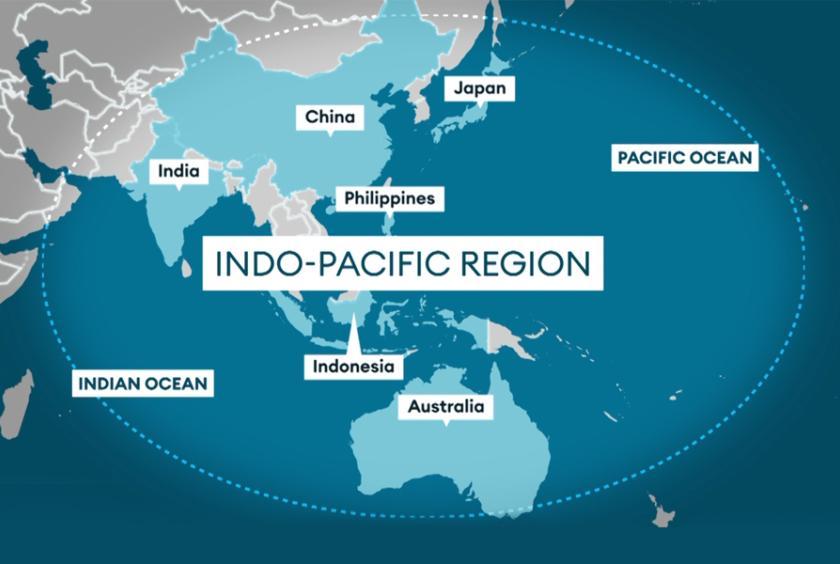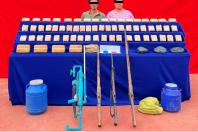■ Taiwan issue
The United States waged proxy wars only in its involvement with other countries such as Korea, Vietnam, Iraq and Afghanistan. Since becoming a powerful country after World War II, the United States has not accepted any war inside its country, but has exported wars to other countries in its own interest. Not only the U.S. but also other powerful countries like China and Russia do not want to see wars in their own countries. Instead, these countries want to wage proxy wars. Being a strategically important country, Myanmar may become a victim of the United States in its control policy on China. Currently, we need to take a lesson from the fact that Ukraine became a proxy of the U.S. in its counteraction policy. We do not want Myanmar to become a battleground for U.S. proxy wars. We do not want Myanmar to become a country to which the U.S. exports its wars. After taking a look at the destroyed cities of Ukraine, it is important to only address our country’s issues politically on a negotiation table at a certain time for our ideological differences.
Studying the Taiwan issue, we should talk about its geopolitics first. Geopolitically, the Indo-Pacific comprise countries such as Australia, Bangladesh, Bhutan, Brunei, Cambodia, Fiji, India, Indonesia, Japan, Laos, Malaysia, Maldives, Myanmar, Nepal, New Zealand, Papua New Guinea, the Philippines, Singapore, Sri Lanka, Taiwan, Thailand, the United States and Vietnam. In its foreign policy, the U.S. has always paid attention to the Indo-Pacific region in order to have political, economic and military influences.
Taiwan has become the best spot in the Indo-Pacific region for the U.S. to control China which is substantially growing in economy. Again, the South China Sea is the lifeblood of global trade. The international trade flowing through South China Sea is worth about US$1.2 trillion every year. That amount includes over half of Indian trade, over two thirds of Australian trade, and nearly 60% of Japanese trade. Such trade has to flow through South China Sea Lines of Communication - SLOCs to reach all parts of the globe.
The Chinese government has repeatedly questioned the United States, which is building up military power in the South China Sea in support of Taiwan, if it recognizes the One China policy. On July 26, 2021, when Chinese Foreign Minister Wang Yi met with U.S. Deputy Secretary of State Wendy Sherman in Tianjin, he underlined three basic demands as bottom lines on how to effectively manage differences and prevent China-U.S. relations from getting out of control. He stressed that the United States must not challenge, slander or even attempt to subvert the path and system of socialism with Chinese characteristics; the United States must not attempt to obstruct or interrupt China's development process; and the United States must not infringe upon China's state sovereignty, or even damage China's territorial integrity.
Considering whether the U.S. has followed and will follow these three points, we need to look at U.S. military interventions with Taiwan, part of China’s territory or a neighbouring island of China. Really in history, the United States has played Taiwan as its proxy by showing a double standard attitude in its own interest and in its bid to control China.
This is also an answer to the question of why the U.S. is encouraging Taiwan overtly or covertly. The most significant example is a visit of Nancy Pelosi as the speaker of the United States House of Representatives to Taiwan. The aim was likely to show that the U.S. does not lack its strong desire for exert control over China as the Ukraine wars intensifies or prevent China from providing military aid.
U.S. Speaker Nancy Pelosi with Taiwan President Tsai Ing- Wen on August 3, 2022afp.jpeg

■ Nancy Pelosi’s visit to Taiwan
United States politician Nancy Pelosi, while serving as the speaker of the U.S. House of Representatives, visited Taiwan (officially the Republic of China) on August 2, 2022. The two-day trip to Taiwan was part of tour of Asia that also included stops in Singapore, Malaysia, South Korea, and Japan. The White House claimed that it did not officially support the trip. Shortly after her arrival, Pelosi said that her visit was a sign of the United States' "unwavering commitment to supporting Taiwan's vibrant democracy." a meeting with President Tsai Ing-wen. Taiwanese wearing yellow and blue clothes, colours of the Ukraine flag, accorded welcome to her. On the morning of the day of the visit, August 2, it was still not known for certain whether the visit to Taiwan would take place. White House Coordinator for Strategic Communications at the National Security Council representative John Kirby said on the evening of August 1 (EDT) that China could respond with a missile launch near Taiwan or could conduct other military exercises to show its disapproval of the visit of an American politician. At the same time, Kirby said that the US was not afraid of threats from China and would not sit idly by in the event of any aggression.
Pelosi's delegation arrived without incident in Taipei, Taiwan, at 10:43 pm on August 2 via a US Air Force transport plane and was received by Minister of Foreign Affairs Joseph Wu. Upon Pelosi's arrival, both the ruling Democratic Progressive Party and opposition Kuomintang endorsed the visit. On August 3, she met with President Tsai Ing-wen, who awarded her the Order of Propitious Clouds. She addressed the legislature. In a press release, Pelosi declared that the visit "in no way contradicts longstanding United States policy. The United States continued to oppose unilateral efforts to change the status quo, she said. NSC representative Kirby reiterated this perspective at a press conference held during the visit saying, "The Speaker's visit is totally consistent with our longstanding One China policy." Pelosi departed Taiwan for South Korea after 6:00 pm on the evening of August 3.
The People's Republic of China had strongly condemned the visit, and called the visit a "provocation" by the US that "seriously infringes upon China's sovereignty". In a telephone meeting between US President Joe Biden and PRC leader Xi Jinping the week before, the PRC government warned the US to abide by the One China principle, that "those who play with fire will perish by it", and that the US would be "playing with fire" if Biden were to allow Pelosi to visit the ROC.
In response to Pelosi landing in Taipei, on the night of August 2, the PLA Eastern Theater Command began joint naval and air force exercises in areas north, southwest and southeast of Taiwan; long-distance, live-fire artillery shooting in the Taiwan Strait; and conventional-headed missile test firings in waters east of Taiwan. Taiwan's Ministry of National Defense (MND) reported twenty-one People's Liberation Army (PLA) planes flew into its air defense identification zone (ADIZ) on August 2. The MND reported that 22 PLA aircraft entered its ADIZ crossing the median line of the Taiwan Strait, and an additional five fighters entered the southwestern part of its ADIZ on August 3. In addition, the PRC began military drills in six areas encircling Taiwan on August 4, which ended on August 7. Taiwan reported 11 Chinese Dongfeng ballistic missiles were fired on August 4, while Japan reported nine ballistic missiles were fired and five of which landed in its exclusive economic zone, southwest of the Yaeyama Islands.
The US ambassador to Beijing, Nicholas Burns, was summoned by the Chinese Foreign Ministry to protest Pelosi's visit.
On August 5, the Chinese Foreign Ministry announced sanctions on Pelosi and her immediate family in response to her visit to Taiwan.
Similarly, Republican Senators exhibited rare support for Pelosi. Senate Republican leader Mitch McConnell was joined by 25 other Republican senators in expressing support for Pelosi's trip to Taiwan. In justifying their support, the Republican senators called the trip "consistent with the United States' One China policy".
■ Taiwan or the Republic of China
Taiwan, officially the Republic of China-ROC is a country in East Asia. Although it has practical relations with powerful countries such as the U.S., Europe and Japan, it is only recognized by a few countries as multiparty democratic country. Taiwan, also known as Formosa, is located at the junction of the East and South China Seas in the northwestern Pacific Ocean, with the People's Republic of China (PRC) to the northwest, Japan to the northeast, and the Philippines to the south. The territories controlled by the ROC consist of 168 islands, with a combined area of 36,193 square kilometres (13,974 sq mi). The main island of Taiwan, also known as Formosa, has an area of 35,808 square kilometres (13,826 sq mi), with mountain ranges dominating the eastern two-thirds and plains in the western third, where its highly urbanized population is concentrated. With around 23.9 million inhabitants, Taiwan is among the most densely populated countries in the world.
■ History
ROC was included in the entire China and Mongolia when it was founded in 1912. In 1945 after World War II, Taiwan Island and the Penghu Archipelago from Japan came under control ROC. The Kuomintang government retreated to Taiwan after losing the civil war in China in 1949. Currently, the ROC government could retain only the areas of Taiwan, Penghu, Kinmen, and Matsu. After the civil war, the Chinese Communist Party that defeated the Kuomintang founded People’s Republic of China-PRC in mainland China.
Under the ROC constitution, the areas under the control of the ROC government are referred to as the free area of the Republic of China. Its capital if Taipei.
The Republic of China-ROC founded by Dr Sun Yat-sen in mainland China in 1912 was globally known as the Republic of China-ROC. It became an initial member of the United Nations founded on October 24, 1945. The China Communist Party led by Mao Zedong, proclaimed that the Republic of China-ROC was founded on October 1, 1949. The ROC government not only lost control of capital Beijing but also left mainland China and moved to Taipei on December 7, 1949. All the ROC-controlled areas were surrendered to the Communists on May 1, 1950.
The ROC government in Taiwan could not control or represent the centralization but used the word China as the name of the country. As there was only a seat representing China at the UN, conflict over a representational seat for the PCR government and the ROC government has existed for about two decades.
In 1971, the UN officially recognized the PRC government led by Mao Zedong in Beijing for a representational seat for China. The ROC government made a complaint but there were only 13 out of 193 UN member countries that supported it.
Former Presidents Lee Teng-hui and Chen Shui-bian claimed that the ROC did not need to declare independence as it was a sovereign nation unrelated to mainland China. Former President Ma Ying-jeou claimed that the ROC was a separate independent country that had sovereign power over both Taiwan and mainland. Such a standing was similar to the ROC constitution and One China policy.
From 1910 to 1940, ROC was referred to as China. From 1950 to 1960, it was referred to as the nationalist China or independent China. At present, the ROC is mostly called Taiwan. Since 1970s, China has been referred to as the PRC.
■ One China principle
The One China principle is the position held by the People's Republic of China (PRC) that there is only one sovereign state under the name China, with the PRC serving as the sole legitimate government of that China, and Taiwan is a part of China.[1][2] It is opposed to the idea that there are two states holding the name "China", the People's Republic of China (PRC) and the Republic of China (ROC); as well as the idea that China and Taiwan form two separate countries.
It refers to the interpretation of the 1992 Consensus asserted by the ROC's then-governing political party Kuomintang (KMT) that both the PRC and ROC had agreed that there is one "China", but disagreed on whether "China" is represented by the PRC or ROC.
Five years after the signing of the Sino-American Defense Treaty on December 2, 1954, U.S. President Dwight Eisenhower, participating in a military parade with Chinese leader Chiang Kai-shek, greets a crowd in Taipei.wikipedia.jpg

■ Taiwan–United States relations
WWII-democratization
As the Korean War broke out, the Truman Administration resumed economic and military aid to the ROC on Taiwan and neutralized the Taiwan Strait by United States Seventh Fleet to stop a Communist invasion of Formosa as well as a potential ROC counter-invasion of the mainland. US military presence in Taiwan consisted of the Military Assistance Advisory Group (MAAG) and the United States Taiwan Defense Command (USTDC). Other notable units included the 327th Air Division. Until the US formally recognized the People's Republic of China in 1979, Washington provided ROC with financial grants based on the Foreign Assistance Act, Mutual Security Act and Act for International Development enacted by the US Congress. A separate Sino-American Mutual Defense Treaty was signed between the two governments of US and ROC in 1954 and lasted until 1979.
The U.S. State Department's official position in 1959 was:
That the provisional capital of the Republic of China has been at Taipei, Taiwan (Formosa) since December 1949; that the Government of the Republic of China exercises authority over the island; that the sovereignty of Formosa has not been transferred to China; and that Formosa is not a part of China as a country, at least not as yet, and not until and unless appropriate treaties are hereafter entered into. Formosa may be said to be a territory or an area occupied and administered by the Government of the Republic of China, but is not officially recognized as being a part of the Republic of China.
During the early Cold War the United States deployed nuclear weapons on Taiwan as part of the United States Taiwan Defense Command. In 1972, United States president Richard Nixon ordered nuclear weapons to be removed from Taiwan and this was implemented by 1974.
At the height of the Sino-Soviet Split, and at the start of the reform and opening of People's Republic of China, the United States strategically switched diplomatic recognition from the Republic of China (ROC) to the People's Republic of China (PRC) on January 1, 1979, to counter the political influences and military threats from the Soviet Union. The US Embassy in Taipei was 'migrated' to Beijing and the Taiwanese Embassy in the US was closed. Following the termination of diplomatic relations, the United States terminated its Mutual Defense Treaty with Taiwan on January 1, 1980.
On April 10, 1979, U.S. President Jimmy Carter signed into law the Taiwan Relations Act (TRA), which created domestic legal authority for the conduct of unofficial relations with Taiwan. As per TRA, The American Institute in Taiwan – AIT was established. U.S. commercial, cultural, and other interaction with the people on Taiwan is facilitated through the AIT. The institute has its headquarters in the Washington, DC area and has offices in Taipei and Kaohsiung. It is authorized to issue visas, accept passport applications, and provide assistance to U.S. citizens in Taiwan. A counterpart organization, the Taipei Economic and Cultural Representative Office in the United States (TECRO), has been established by Taiwan. It has its headquarters in Taipei, the representative branch office in Washington, DC, and 11 other Taipei Economic and Cultural Offices (TECO) in the continental U.S. and Guam. The Taiwan Relations Act (TRA) continues to provide the legal basis for the unofficial relationship between the U.S. and Taiwan, and enshrines the U.S. commitment to assisting Taiwan maintain its defensive capability.
After de-recognition, the U.S. still maintains unofficial diplomatic relations with Taiwan through Taipei Economic and Cultural Representative Office; the current head of TECRO in Washington, D.C. is Stanley Kao. The American Institute in Taiwan, a non-profit institute headquarters in the US soil under the laws of the District of Columbia in Arlington County, Virginia and serves as the semi-official, working-level US representation and AIT has branch offices in Taipei and Kaohsiung. The Chairman of AIT is Raymond Burghardt. Christopher J. Marut was appointed to be the new AIT Taipei Office Director in August 2012.
Taiwan helped Ronald Reagan circumvent the Boland Amendment by providing covert support to the Contras in Nicaragua.
Reagan pressured Taiwan into giving up its Sky Horse ballistic missile program.
Taiwan's secret nuclear weapons program was revealed after the 1987 Lieyu massacre when Colonel Chang Hsien-yi Deputy Director of Nuclear Research at INER,[29] who was secretly working for the CIA, defected to the U.S. in December 1987 and produced a cache of incriminating documents. The CIA oversaw negotiations with the Taiwanese which led them to abandon their nuclear ambitions in return for security guarantees. Since the end of the nuclear weapons program the “Nuclear Card” has played an important part in Taiwan's relationship with the United States.
Post-democratization
In 1997 the Speaker of the United States House of Representatives, Newt Gingrich, traveled to Taiwan and met with President Lee Teng-hui.
In July 2002, Justice Minister Chen Ding-nan became the first Taiwanese government official to be invited to the White House since 1979.
The Taiwan Policy Act of 2013 was passed by the U.S. Congress in the House Foreign Affairs Committee and updated the terms of U.S.-Taiwan relations. In 2015, Kin Moy was appointed director of AIT.
Taiwan and the United States have maintained the trade ties and expanded it since 1979. Taiwan was ready to enter US markets with the Export-Import Bank financing, guarantees of overseas private investment corporation and Normal Trade Relations (NTR) status. In recent years, AIT business relations with Taiwan have focused on expanding the market for American goods and services. The AIT held a series of trade talks focused on copyright issues and market access for US goods and services.
On December 16, 2015, the Obama administration announced a deal to sell US$1.83 billion worth of arms to the Taiwanese military, and one year and eight months later, the U.S. House of Representatives passed the Taiwan Relations Act Affirmation and the Naval Vessel Transfer Act of 2014, which authorized the sale of Oliver Hazard Perry-class frigates to Taiwan. This includes two US Navy frigates suspended amid territorial disputes in the South China Sea, the sale of anti-tank missiles, amphibious assault vehicles and the FIM-92 Stinger, a surface-to-air missile. China's Ministry of Foreign Affairs has expressed its disapproval of the sales and issued a strong warning that it will harm Sino-US relations.
A new US$250 million compound for AIT in Taiwan was opened in June 2018 with a low-level US delegation, which Chinese authorities considered a violation of China's one-China policy and called on the US to stop any ties with Taiwan.
In September 2018, the United States approved the sale of US$330 million worth of aircraft spare parts and other equipment to maintain Taiwan's air force.
In July 2019, the US Department of State announced that the sale of M1A2T Abrams tanks, Stinger missiles and related equipment to Taiwan at an estimated cost of US$2.2 billion was approved.
In May 2020, the U.S. Department of State approved an agreement to sell 18 MK-48 Mod 6 Advanced Technology Heavy Weight torpedoes to Taiwan as a possible foreign military sale, worth an estimated US$180 million.
On August 9, 2020, US Secretary of Health and Human Services Alex Azer went to Taiwan to meet with President Tsai Ing-wen, becoming the first US official to visit Taiwan since the breakdown of diplomatic relations between Washington and Taipei in 1979. In September 2020, the Under Secretary for Economic Growth, Energy and the Environment Keith J. Krach attended a memorial service for former Taiwanese president Lee Teng-hui.
In September 2020, U.S. Ambassador to the United Nations Kelly Craft met for lunch in New York City with James K. J. Lee, Director General of the Taipei Economic and Cultural Office in New York. Lee, who served as chief secretary of Taipei's foreign ministry until July, was meeting with a top Taiwanese official for the first time as US ambassador to the United Nations. Craft said she and Li discussed ways the U.S. could help Taiwan become more involved in the United Nations, and he pointed out that the WHO ignored an email from Taiwan sent in December 2019, which acknowledged and warned about the risk of person-to-person transmission of the highly contagious new COVID-19 virus in China.
In October 2020, the US Department of State approved an agreement between the US and Taiwan worth US$2.37 billion. This includes the possible sale to Taiwan of 400 Harpoon anti-ship cruise missiles including related radars, transporter erector launchers and technical support.
In January 2021, Taiwan President Tsai Ing-wen met with U.S. Ambassador to the United Nations Kelly Craft via video. Craft said, "We discussed many ways in which Taiwan's success in the fight against COVID-19 and health, Taiwan: a model for the world, as demonstrated by all that Taiwan has to offer in the fields of technology and cutting-edge science. The United States will always stand with Taiwan," she said. "Some American politicians will have to pay a heavy price for their wrong words and actions," Chinese Foreign Ministry spokesman Zhao Lijian said in Beijing. Later that month, on her last day in office, Craft called Taiwan “a force for good on the world stage – a vibrant democracy, a generous humanitarian, a responsible participant in the global health community and a zealous promoter and protector of human rights."
In June 2021, a congressional delegation including Tammy Duckworth, Dan Sullivan (US Senators) and Christopher Coons visited Taiwan briefly and met with President Tsai Ing-wen. China strongly objected because they used C-17 military cargo aircraft.
On March 3, 2021, the Biden administration reaffirmed the strength of the relationship between the United States and Taiwan in the Interim Guidance on the Administration's National Security Strategy. On March 8, 2021, the Biden administration made the following proposal at a press conference. It said, "We will stand with our friends and allies to promote the prosperity, safety and values we share in the Indo-Pacific region. We will maintain our long-term commitments as outlined in the Three Consensuses, Taiwan Relations Act and the Six Guarantees. In addition, we will continue to assist Taiwan in maintaining an adequate self-defense capability."
On May 23, 2022, during his trip to Asia, President Biden pledged to defend Taiwan with the U.S. military in the event of a Chinese invasion. At the end of May, Illinois Senator Tammy Duckworth led a congressional delegation to Taiwan.
In late May 2022, the U.S. Department of State reconfirmed a line from U.S.-Taiwan relations fact sheet that had been removed earlier in May. The sentence read "No Support for Taiwan Independence". But another line that was removed earlier from the U.S.-Taiwan relations fact sheet was not reinstated. It was written "Recognizing China's sovereignty over Taiwan".
A new line was also added to the updated fact sheet, "The United States will continue to maintain its capabilities in a manner consistent with the Taiwan Relations Act to counter any efforts by China to undermine Taiwan’s security, sovereignty and prosperity."
In July 2022, Senator Rick Scott led a congressional delegation to Taiwan.
On August 2, 2022, US House Speaker Nancy Pelosi led a congressional delegation to Taiwan, prompting China's military and economic response. In late August, a congressional delegation led by Massachusetts Senator Ed Markey visited Taiwan. Indiana Governor Eric Holcomb (who became the first Indiana governor to visit Taiwan since 2005) also visited Taiwan. At the end of August, Tennessee Senator Marsha Blackburn visited Taiwan. At the end of August and the beginning of September, the governor of Arizona, Doug Ducey, also visited Taiwan.
■ Tensions over Taiwan in 2022
China's diplomatic and military pressure on Taiwan is a threat to all democracies, and the United States is committed to providing assistance for Taiwan's self-defense, AIT's director of non-diplomatic relations with Taiwan, Sandra Oudkirk, told the American Chamber of Commerce in Taiwan on March 30.
The Chinese military said on May 11 that it had warned and monitored a US warship as it sailed through the politically sensitive Taiwan Strait shortly after China conducted military exercises near Taiwan. On May 10, the US Navy's 7th Fleet responded that the USS Port Royal, a large cruise ship equipped with a ballistic missile system, crossed the Taiwan Strait in accordance with international law and operated routinely in international waters.
US President Joe Biden said on May 23 that if China invades Taiwan, the United States will defend Taiwan militarily, and he warned that China is defying the threat.
On June 10, China's Defense Minister Wei Fenghe warned US Defense Secretary Lloyd Austin that if Taiwan declares its independence, China will not hesitate to start a war. Wei made the warning in a private face-to-face meeting with Austin at a security conference dubbed the Shangri-La talks in Singapore.
Amid rising tensions between Taiwan and China, US and Japanese forces have drawn up a draft plan for a joint operation over the Taiwan issue, the Kyodo news agency reported on December 23, citing unnamed government sources. According to the plan of the United States and Japan, in the first phase of the Taiwan emergency, the US Marine Corps will be stationed with temporary military bases on Nansei Islands, which can be connected to Taiwan from Kyushu islands, one of Japan's four main islands, Kyodo News reported. The report said that the Japanese armed forces would have to help in the logistics sector such as ammunition and fuel supplies in these areas.
US Air Force chief Frank Kendall said on August 19 that China's actions around Taiwan have raised risks, and he hopes China's behavior will return to the parameters previously established.
The White House said on August 12 that it would increase trade with Taiwan in response to China's provocative behavior as the United States insists it has air and sea transit rights through the Taiwan Strait. The new trade plan will be unveiled in the coming days, as White House Asia-Pacific Affairs Coordinator and adviser to President Joe Biden, Kurt Campbell, said U.S. forces would transit the Taiwan Strait in the coming weeks.
President Joe Biden said on September 18 that the United States will protect Taiwan from Chinese aggression while the White House said that the US policy has not changed. When asked on CBS's 60 Minutes program whether or not US forces will protect Taiwan, President Biden replied that they would, and he said that he would protect Taiwan in the event of an unprecedented attack.
On September 19, the Chinese government responded that President Joe Biden's comment that the United States would protect Taiwan from Chinese aggression was a serious violation of American policy on the island of Taiwan.
US Defense Secretary Lloyd Austin said on October 2 that the United States will help Taiwan improve its ability to defend itself against Chinese aggression. However, he did not say that he would send troops to the island of Taiwan, as President Joe Biden had promised.
US Vice President Kamala Harris reaffirmed America's commitment to Japan's defense during a meeting with Japanese Prime Minister Fumio Kishida in Tokyo on September 26, and the two condemned China's actions in the Taiwan Strait.
China wants to annex Taiwan more quickly than previously thought, US Secretary of State Antony Blinken said on October 17, warning that President Xi Jinping is leading China in a more aggressive stance than before. Blinken spoke at a forum held at Stanford University with former US Secretary of State Condoleezza Rice.
A senior U.S. military admiral warned on October 19 that the U.S. military must prepare to respond to a possible invasion of Taiwan as early as this year, a sign of growing concern about China's intentions on the island of Taiwan.
■ A US military bill that would provide up to US$10 billion in military aid to Taiwan
The U.S. Congress is set to vote on a major military bill, including authorizing up to US$10 billion in security aid and speeding up the transfer of military equipment to Taiwan. The US Congress will vote on the bill as China steps up pressure on Taiwan.
A revised bill of the annual National Defense Authorization Act (NDAA) did not include some of the controversial Taiwan-related provisions lawmakers passed earlier this year, including a proposal to impose sanctions or designate Taiwan as a major non-NATO ally if China significantly escalates its provocations.
The Senate and House Armed Services Committees introduced the NDAA bill late on December 6. A US$858 billion military bill is expected to be signed into law this month after Congress passed it.
Under the Taiwan Enhanced Resilience Act, which is part of the NDAA, it would increase its defense spending for Taiwan, including US$2 billion in military aid to Taiwan from 2023 to 2027 if approved by the U.S. Secretary of State.
■ US and China's strategic rivalry in the South China Sea
As the security interests and activities of major countries in world politics become a contradiction, the politics and military situation of the South China Sea has become a dangerous situation. China is rapidly increasing its ability to expand in the South China Sea and beyond. At the same time, the United States has entered the year of its most significant expansion of power in the region in a generation.
On many issues, the situation has worsened, with continued tensions over Taiwan and the US's freedom of navigation stance challenging China's territorial claims in the South China Sea. This is the rivalry between the US and China. In addition, there is competition between China and some Southeast Asian countries for natural resources.
The US and China's competition for influence in the region, particularly in the South China Sea, where their strategic alignments are aligned, is impacting the entire political environment. China, in the event of a conflict, is pursuing a strategy of controlling the seas around it and preventing the US from entering.
The US is building deterrence capabilities to make a response to China's command and control, communication, technology, and surveillance and reconnaissance (ISR) systems. As such, ISR is a major priority for both countries, and they are competing to gain an advantage in this regard in the waters around China.
The main reason the South China Sea is important to China is because it provides considerable security for the deployment of counterattack nuclear-powered submarines based in Yulin, Hainan Province. The U.S. is using its ISR capabilities to track submarines and target them if necessary to prevent China from getting that chance.
This is the strategic reasoning behind US ISR operations, and China is trying to keep US ISR operations as close as possible to their military facilities.
It is likely that the United States will increase the deployment of military equipment in partner countries, which will draw these countries deeper into the conflict. Among them, the main country involved is the Philippines. The Philippine government wants US backing in responding to China's aggressive actions in the South China Sea.
However, the US is willing to keep its military equipment in the Philippines by implementing the US-Philippines Defense Cooperation Enhancement Agreement for mutual protection, which is currently being considered by Philippine President Ferdinand Marcos Jr.











